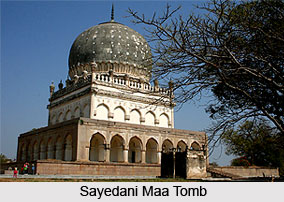 Sayedani Maa Tomb, situated in Hyderabad city of Andhra Pradesh, was built by Nawab Abdul Haq Diler Jung, an officer in the court of the 6th Nizam of Hyderabad. The monument was the tribute of a son to the loving memory of his mother and reverence to the values she adhered to in life. It was erected in 1883 AD and is also known as Maa Saheba Ke Dargah or Saidani Maa Ki Dargah. The tomb has lately lost its beauty owing to the pollution. However Archaeological Survey of India has undertaken the preservation and restoration work of the tomb.
Sayedani Maa Tomb, situated in Hyderabad city of Andhra Pradesh, was built by Nawab Abdul Haq Diler Jung, an officer in the court of the 6th Nizam of Hyderabad. The monument was the tribute of a son to the loving memory of his mother and reverence to the values she adhered to in life. It was erected in 1883 AD and is also known as Maa Saheba Ke Dargah or Saidani Maa Ki Dargah. The tomb has lately lost its beauty owing to the pollution. However Archaeological Survey of India has undertaken the preservation and restoration work of the tomb.
History of Sayedani Maa Tomb
Maa Saheba belonged to a royal family and was known to follow her culture and tradition very stringently. Since the tender age of 10, she strictly followed the custom of `Purdah` in such manner that it became an inseparable part of her life. She was so much devoted to her culture that she had wished to be entombed in such a way, much beneath the surface, so that only women would be able to pay their homage to her. Nawab Abdul Haq Diler Jung was the dutiful son of Maa Saheba. As per the insistence of her mother he built Sayedani Maa Tomb in exactly the way Maa Saheba wanted it to be. Nawab Abdul Haq Diler Jung was positioned in the court of Mahbub Ali Khan Asaf Jah VI, the 6th Nizam of Hyderabad as an officer. Owing to his good position he managed to procure money for structuring the tomb in the honour of her mother.
Architecture of Sayedani Maa Tomb
Sayedani Maa Tomb has a gorgeous architecture having beautiful lattice work. The grave of Maa Saheba is structured in ancient fashion which exhibits a blend of Qutb Shahi and Mughal architectural styles. The dome has an onion shape, a common feature of Islamic architecture. Stunning stucco work and fine arches adorn the interior and exterior of the tomb. The onion shaped dome is richly carved with marble lattice work. Small minarets made of lime and mortar can be witnessed on the upper pavilion. They are embellished with intricate carvings and marble inlay work. There is an underground chamber inside the mausoleum where only women get the permission to enter.




